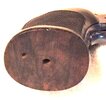You are using an out of date browser. It may not display this or other websites correctly.
You should upgrade or use an alternative browser.
You should upgrade or use an alternative browser.
H & R USRA holes in grip
- Thread starter orpington
- Start date
Blue68f100
Member
They may have been there to hold the grips in position for the CNC machine to do its think. Other than that makes me wonder if they were on a display or something. I would contact the mfg if you just purchased them and ask.
The revolver dates from the late 1930s. The holes may be part of its history, and possibly should remain. Or, since these grips were designed to be interchangeable with others, held in place with one screw, maybe I replace with a set with no holes. But how hard is it to find these? Or I plug them with a plug of walnut, but this seems like the least attractive option as they will forever look plugged and maybe obscures something that has to do with modifications employed by pre WWII target shootersThey may have been there to hold the grips in position for the CNC machine to do its think. Other than that makes me wonder if they were on a display or something. I would contact the mfg if you just purchased them and ask.
NIGHTLORD40K
Member
Only reason behind them I can think of was someone had a lanyard ring there at some point, or maybe a counterweight.
I'm fairly certain any pre-war Sportsman grips that utilize a single hole at the bottom of the backstrap will fit. Mine sure looked and felt identical to the Sportsman.
As long as the rest of the grip is decent, I'd chalk the holes up to history and leave 'em be.
I'm fairly certain any pre-war Sportsman grips that utilize a single hole at the bottom of the backstrap will fit. Mine sure looked and felt identical to the Sportsman.
As long as the rest of the grip is decent, I'd chalk the holes up to history and leave 'em be.
My thought was a lead weight of sorts, I’m surprised it’s not still there.
These have come down a bit, which is what convinced me to buy one. $750 to $850 can buy a nice one. For awhile there, they were a $1000+ pistol, even $1200 seemed low.
These have come down a bit, which is what convinced me to buy one. $750 to $850 can buy a nice one. For awhile there, they were a $1000+ pistol, even $1200 seemed low.
WVGunman
Member
- Joined
- Feb 26, 2014
- Messages
- 380
CNC-machining as we know it may not have existed in the 1930s, but machines designed to reproduce carved wood objects definitely did. These look a lot like pilot holes to keep the grips steady while the checkering was applied, either by man or machine.The revolver dates from the late 1930s.
Mizar
Member
If you plug them, even with dowels cut from the grips, it will show no matter what - just leave them as they are.
A good guess except other examples from this manufacturer do not have these pilot holes.CNC-machining as we know it may not have existed in the 1930s, but machines designed to reproduce carved wood objects definitely did. These look a lot like pilot holes to keep the grips steady while the checkering was applied, either by man or machine.
NIGHTLORD40K
Member
I messaged the gentleman to whom I sold my USRA model to see if he can snap some pics for you.
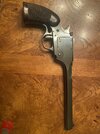
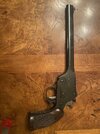
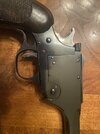
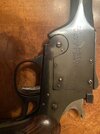
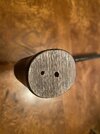
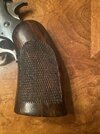
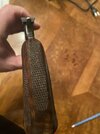
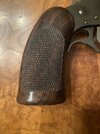
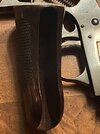
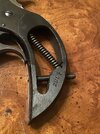 I have this pistol in hand now.
I have this pistol in hand now.First, I must comment on what a high quality pistol from a manufacturer (but not a model) that is not renowned for its workmanship.
These were reaching over 4 figures in value several months to a year or two ago, and seem to have curiously backed off and so I got this one for $825 shipped and that seemed like a good price until I saw two with consecutive serial numbers sell at auction for $700 and $725 each. Add in a buyer’s premium and you’re at or above what mine cost, but presumably the grips didn’t have holes or perhaps a premium was paid if someone wanted the pair with consecutive serial numbers? I don’t see how they can go much cheaper?
Certainly no beauty queen is this model but the workmanship is flawless.
I’m amazed only one screw holds this grip in place, but such it is. There is no serial number in the grip channel. So can be replaced.
Like I said, the workmanship is flawless, but a few things come to mind.
The holes in the grip are not factory. Given the workmanship otherwise, there are the lines of a bandsaw at the base of the grip suggesting it was truncated. But how much was available to remove? And why? Or maybe this is correct and unfinished at the base of the grip, but this seems very odd??? Also, likely correct, but I’m surprised the checkering at either side doesn’t have a border. Particular nice is the section of checkering on the midline of the grip.
NIGHTLORD40K
Member
Very nice. The twin brother of mine. Wait till you shoot it.....just make sure no one is standing right behind you when you open it! 
Jim Watson
Member
Compared to old catalog cuts, the grip appears not to have been shortened. I can’t explain the saw marks or holes. I suggest you make up an interesting story and stick with it.
I was once in love with an Ultra Sportsman but bids soon exceeded my affection.
I was once in love with an Ultra Sportsman but bids soon exceeded my affection.
I didn’t think they were shortened either which makes the bandsaw marks puzzling. Unless that’s the way they left the factory, which would be odd. The margins surrounding the checkering suggests this was the original configuration and not cut, as well. The holes are a modification by a target shooter for some unknown reason.Compared to old catalog cuts, the grip appears not to have been shortened. I can’t explain the saw marks or holes. I suggest you make up an interesting story and stick with it.
I was once in love with an Ultra Sportsman but bids soon exceeded my affection.
As this grip is not numbered to the pistol, I might replace if I somehow stumble across another grip. The grain is attractive on this grip.
Maybe I’ll find a Roper grip as Walter Roper worked for H & R during this time frame.
Similar threads
- Replies
- 6
- Views
- 3K


